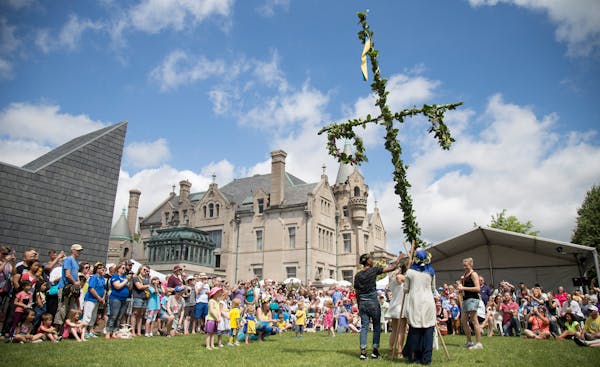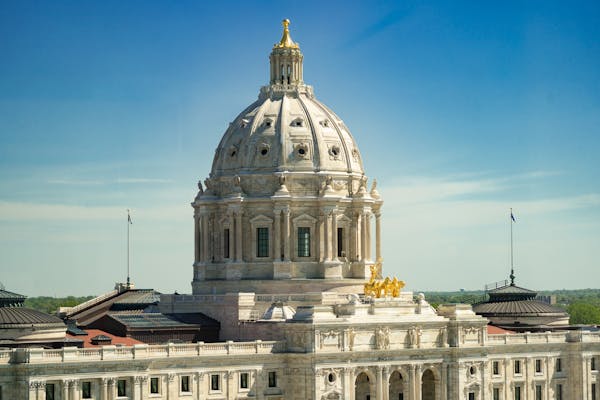Why is Minnesota's Democratic Party called the DFL?
Listen and subscribe to our podcast: Via Apple Podcasts | Spotify | Stitcher
For most of his life, Damon Moss had really only known two major political parties in state politics: Democrats and Republicans. Until he came to Minnesota.
When Moss first moved to Minneapolis in 2009, he recalled hearing frequent references to the DFL on Minnesota Public Radio."I couldn't quite follow along with what they were talking about," he said.
Wondering about the backstory, Moss turned to Curious Minnesota, the Star Tribune's community-driven reporting series, to ask: Why is the Democratic Party in Minnesota known as the Democratic-Farmer-Labor-Party, or DFL?
The DFL that Minnesotans know today, which boasts two current senators, five representatives and a governor, exhibits few signs of its radical history. While DFL U.S. Sen. Amy Klobuchar remains one of the more moderate Democratic candidates in the presidential race, her party used to have more in common with left-wing candidates like Sen. Bernie Sanders of Vermont.
The Democratic Party of Walter Mondale and Hubert Humphrey was also the party of a determined faction of Minnesota communists who infiltrated the organization after World War II in vehement opposition to President Harry Truman.
Although the DFL officially formed in 1944, the result of a merger between the Farmer-Labor Party and the Democrats, the party's radical roots are much older.
In the decades after Minnesota's inception as a state in 1858, the Republican Party maintained a firm advantage over Democrats and other parties in the Legislature. Republicans held a majority in the Minnesota Senate from 1860 to 1931 and a majority in the state House of Representatives for all but two years during that period. The party also possessed the governorship for all but eight years during that 70-year span.
However, poor economic conditions for farmers and workers led to the emergence of the Farmer-Labor Party in 1918, one of many parties with socialist influences in the United States. Next door, Wisconsin sent Social Democratic Party of America founder Victor Berger to Congress, while North Dakotans started a socialist political organization called the Non-Partisan League.
Despite their initial exclusion from the Farmer-Labor Party, communists curried favor with its politicians, including former Minnesota Gov. Floyd B. Olson, with their strong criticism of fascism in the 1930s.
"I think what helped them align with the Farmer-Labor camp was the Soviet Union getting involved with [World War II]," said Brian Pease, the State Capitol site manager for the Minnesota Historical Society. "It did later become a problem for the merger because the Democrats pretty much were anti-communist."
In a unification born more from necessity than alignment, Democrats and the Farmer-Labor Party merged on April 15, 1944, in order to present a united front against Nazi Germany during World War II, creating the Democratic-Farmer-Labor Party.
Despite the party's national popularity, Democrats were really "not a player" in Minnesota politics before that, Pease said. The Farmer-Labor Party had three governors and several senators and representatives in the 1930s, while the Democrats managed to elect just one member to the House. Farmer-Laborers appealed more directly to struggling agrarian workers and trade unions in Minnesota than the anemic Democratic Party did at the time, Pease said.
During the merger negotiations, the Democrats agreed to combine the party names because of the Farmer-Labor Party's popularity in the state, said Jules Goldstein, a DFL state director.
The more left-wing members within the DFL quickly came to oppose President Truman's anti-communist stance, pitting them against the moderates of the party, led by Hubert Humphrey.
However, the radicals lost influence within the DFL after supporting Henry Wallace's independent presidential bid to defeat Truman in 1948, according to Goldstein.
Despite the conflict, internal ideological struggles in the DFL catapulted several state politicians into national prominence.
As a young 32-year-old Democrat at the time of the merger, Humphrey saw the unification as an opportunity to present voters in Minnesota with a party devoted to stopping the fascists in Europe. After his battles with the more extreme members of the DFL, Humphrey was elected to the U.S. Senate and served as the 38th vice president of the United States.
"He was a young, talented professor, so he had a lot of political aspirations," Pease said, who credited Humphrey as a leader in a new wave of Democratic politicians after World War II.
Orville Freeman also played an important role in pushing the far left out of the DFL, becoming the DFL's first governor in 1955 and U.S. Secretary of Agriculture. Freeman worked closely with a very young Walter Mondale to build DFL support for Humphrey in his 1948 U.S. Senate race.
"If you look at Minnesota's political history, a lot of people call us the 'Maverick State' just because we never were really Republican or Democrat," Pease said. "It's a pretty important part of our political history."
---
If you'd like to submit a Curious Minnesota question, fill out the form below:
Read more Curious Minnesota stories:
Why do we have water towers and what do they do?
Who are all the people on sidelines during Vikings games?
Why are Honeycrisp apples still so expensive?
Why is it so much harder for U students to graduate debt free compared with the 1960s?
How did Minnesota become one of the most racially inequitable states?
How did these 11 Minnesota towns get their unusual names?
Has Minnesota every had a major earthquake?




